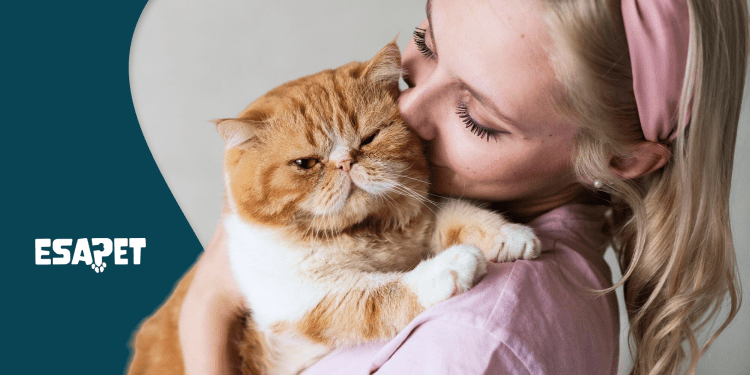Emotional Support Cat: The Mental Health Benefits Explained (2026 Guide)

If you’re feeling overwhelmed by anxiety, depression, or other emotional challenges, an emotional support cat might be exactly the companion you need. More than just a pet, an ESA cat offers comfort, stability, and a calming presence that can make a real difference in your daily life.
In this guide, you’ll learn how to make your cat an official emotional support animal, understand the benefits they bring, and discover your legal rights — including housing protections that allow you to live with your ESA cat, even in “no pets” buildings. Let’s explore how your feline friend can help support your mental well-being.
What is an ESA cat?
An ESA cat, also Emotional Support Animal cat — is a companion animal that provides comfort, companionship, and emotional stability to individuals dealing with mental or emotional disabilities like anxiety, depression, PTSD, and chronic stress.
What distinguishes ESA cats is their therapeutic role in supporting a person’s mental well-being. Unlike service animals, they do not require specialized training. Instead, their calming presence and affectionate nature help reduce feelings of loneliness, regulate mood, and alleviate emotional distress. For many, simply having their ESA cat nearby offers daily relief and a stronger sense of emotional balance.
Legally, emotional support animals are protected under the Fair Housing Act (FHA) in the United States. This law mandates landlords and housing providers to make reasonable accommodations for those with ESAs — meaning your ESA cat can reside with you even in housing with strict “no pets” policies, and landlords cannot impose pet fees or deposits on your emotional support animal.
How to Make a Cat an Emotional Support Animal?
To make your cat an official Emotional Support Animal the essential step is to obtain a recommendation from a licensed mental health professional (LMHP) , such as a psychologist, psychiatrist, therapist, or licensed clinical social worker.
During the consultation, the provider will assess whether you’re experiencing a qualifying emotional or psychological condition — such as anxiety, depression, PTSD, or panic disorder — that significantly impacts your daily functioning.
If they determine that the presence of your cat provides therapeutic value and contributes positively to your emotional stability, the LMHP may issue a legally valid ESA letter.
Once issued, this ESA letter formally designates your cat as an emotional support animal. It serves as the basis for requesting housing accommodations under the Fair Housing Act (FHA) — including living with your cat in properties that typically restrict pets or charge pet-related fees.
How to Get an ESA Letter for a Cat?
There are the 3 main steps you follow to get a legitimate ESA letter for a cat:

Pre-Screening

Licensed Therapist

Your Letter
- Free Pre-Screening: The process begins with a free pre-screening where you answer simple questions to determine your qualification for an ESA letter.
- Connect With a Licensed LMHP: If you pre-qualify, you are connected with a therapist licensed in your state for a teleconsultation.
- Receive Your ESA Letter: Upon approval, you receive a compliant ESA letter, typically within 24-48 hours, although some states have longer turnarounds.
Get your Official ESA Letter Consultation from a licensed therapist.
Get ESA Letter Now
Free Pre-Screening
Your journey with ESA Pet starts with a free pre-screening designed to quickly assess your potential eligibility for an ESA letter. During this initial stage, you’ll answer a few simple questions about your mental health and lifestyle.
This is an important preliminary step to ensure that your needs align with the criteria set by the Federal Housing Act (FHA), Americans with Disabilities Act (ADA), and the Department of Justice (DOJ) for an emotional support animal, which is intended to provide emotional, cognitive, or similar support to individuals with disabilities.
This pre-screening helps us confirm if your situation involves a mental health condition that could genuinely benefit from an animal’s companionship, such as anxiety, depression, or PTSD, which are conditions recognized by the Diagnostic and Statistical Manual (DSM). It acts as a helpful first filter, ensuring that we connect individuals with qualifying needs to our licensed professionals.
Connect With A Licensed Therapist
If you pre-qualify, the next crucial step is being connected with one of our knowledgeable and compassionate licensed therapists for a teleconsultation. These are licensed mental health professionals (LMHPs) in your state, who are experienced in evaluating mental health conditions and understanding the therapeutic benefits that emotional support animals can provide.
They assess your individual needs to determine if an ESA cat would genuinely alleviate symptoms of your disability. It is mandatory that your ESA letter meets all legal requirements (both federal and state).
Our therapists are fully licensed, and we adhere to specific state regulations like Arkansas (Arkansas Code § 20-14-1003), California (California Health & Safety Code § 122318), Iowa (Iowa Code § 216.8C), Louisiana (Act No. 558), and Montana (Montana Code § 49-4-221) that require an established 30-day client-therapist relationship before an ESA letter can be issued.
Receive Your Letter
Upon approval by your licensed therapist, you will receive your fully compliant ESA Letter. For most states, we pride ourselves on a quick turnaround, typically within 24-48 hours.
As noted, due to specific state regulations in Arkansas, California, Iowa, Louisiana, and Montana, there is a mandatory 30-day waiting period before the letter can be issued after your initial consultation.
Emotional Support Cat Registration and Certification Explained
How to Register a Cat as an Emotional Support Animal for Free?
Technically, you don’t need to “register” your cat in any database to make them an emotional support animal (ESA). What you do need is a valid ESA letter from a licensed mental health professional (LMHP).
Note: There’s no official registry or ID required by law. Sites that offer “registration” or “certificates” without a real evaluation are often misleading. An ESA letter is the only legal document you need.
Is ESA Certification for Cats Necessary?
No, ESA certification for cats is not necessary — and in fact, there’s no official government registry or certification required for emotional support animals in the U.S.
What is required is a valid ESA letter written by a licensed mental health professional (LMHP). This letter must state that you have a mental or emotional condition and that your cat is recommended as part of your treatment. This document is what grants you rights under laws like the Fair Housing Act, allowing your ESA cat to live with you even in housing with no-pet policies.
How to get a cat certified as an emotional support animal?
You cannot buy or adopt a cat that is already legitimately “certified” as an emotional support animal because certification doesn’t exist. An ESA designation depends entirely on your individual mental health evaluation and a licensed professional’s recommendation. The emotional support role is personal—it’s about how your cat helps you emotionally, not a property of the animal itself.
Emotional Support Cat for Depression: Is It a Good Option?
An Emotional Support Cat for Depression can be a highly beneficial companion. Cats are known for their calm demeanor and affectionate yet independent nature — qualities that can be especially comforting for individuals experiencing emotional distress.
According to a study published in BMC Psychiatry, companion animals like cats contribute to improved emotional well-being, reduced stress, and a greater sense of routine and responsibility in people with mental health conditions.
If you’re considering one, the first step is to consult with a licensed mental health professional. If deemed appropriate, they can issue an ESA letter, which not only validates your cat’s role in your care plan but also grants you housing protections under the Fair Housing Act.
Emotional Support Cat Breeds: Find Your Perfect Companion
When it comes to emotional support cat breeds, some stand out by offering more than just companionship — they provide comfort, emotional balance, and a calming presence for those facing mental health challenges.
While any cat has the potential to be a supportive companion, certain breeds are naturally more affectionate, gentle, and intuitive. These traits make them especially well-suited to serve as emotional support animals (ESAs), forming deep bonds with their owners and helping to ease symptoms of anxiety, depression, and stress through consistent, loving interaction.
Here are 5 popular cat breeds frequently chosen as emotional support companions:
- Ragdoll
- Scottish Fold.
- Sphynx
- Maine Coon
- Siamese

Ragdoll
Known for their remarkably gentle temperament and a strong love of cuddling, Ragdolls are often described as “puppy-like” due to their loyalty and affectionate nature. They are highly sociable cats that enjoy close physical contact and will often seek to stay near their owners throughout the day. This breed’s calm presence and tendency to relax completely when held can provide a soothing effect, making them an excellent choice for individuals dealing with anxiety, depression, or loneliness.
Ragdoll Traits
- Temperament: Remarkably gentle and affectionate, often described as “puppy-like”.
- Social Behavior: Highly sociable, loves close physical contact and stays near owners.
- Emotional Support: Provides soothing presence, ideal for anxiety, depression, loneliness.
- Apartment Living: Adapts well to different environments.
- Flying With the Breed: Generally allowed; check airline policies (usually cargo or cabin depending on size and carrier).

Scottish Fold
Instantly recognizable by their distinctive folded ears, Scottish Folds have a sweet and calm disposition. They are gentle, friendly cats who enjoy spending quiet time with their owners, offering a sense of companionship without overwhelming energy. Their adaptable nature makes them a good fit for various living situations, including apartments or busy households. The comforting presence of a Scottish Fold can help reduce stress and create a peaceful environment conducive to emotional healing.
Scottish Fold Traits
- Temperament: Sweet, calm, and friendly
- Social Behavior: Enjoys quiet companionship without overwhelming energy
- Emotional Support: Helps reduce stress, creates peaceful environments
- Apartment Living: Good fit for apartments and busy households
- Flying With the Breed: Usually cabin-eligible; soft carrier recommended – check airline policies

Sphynx
Although the Sphynx cat is hairless, they are far from aloof. In fact, Sphynxes are known for their outgoing, affectionate, and playful personalities. They crave human attention and interaction, often following their owners from room to room and seeking to be the center of social activity. Their warm skin and constant need for affection can provide tactile comfort and emotional support, especially for those who benefit from physical touch as a coping mechanism.
Sphynx Traits
- Temperament: Outgoing, affectionate, and playful
- Social Behavior: Craves human attention, follows owners around
- Emotional Support: Provides tactile comfort, especially good for those needing physical touch
- Apartment Living: Adaptable, but needs warmth and care due to lack of fur
- Flying With the Breed: Usually cabin-eligible with proper carrier; check airline policies

Maine Coon
One of the largest domestic cat breeds, the Maine Coon combines size with a gentle and friendly nature. Known for their intelligence and sociability, Maine Coons are highly adaptable and often get along well with children and other pets. Their calm, steady demeanor and playful yet easygoing attitude can bring joy and companionship to those coping with stress or mood disorders. Their love for interactive play and socialization encourages owners to engage in activities, which can be therapeutic.
Maine Coon Traits
- Temperament: Gentle, intelligent, friendly
- Social Behavior: Highly sociable, good with children and other pets
- Emotional Support: Brings joy and companionship, helps reduce stress and mood disorders
- Apartment Living: Possible with large enough space and low activity needs
- Flying With the Breed: Usually flies cargo due to size; check airline policies

Siamese
Siamese cats are vocal, affectionate, and highly social animals that thrive on interaction with their humans. They tend to form strong emotional bonds with their owners, often following them around the house and communicating through expressive meows. Their lively and engaging nature provides both emotional comfort and mental stimulation, helping to combat feelings of isolation or depression. Siamese cats’ need for social connection makes them ideal companions for people seeking an interactive and responsive ESA.
Siamese Traits
- Temperament: Vocal, affectionate, and highly social
- Social Behavior: Forms strong emotional bonds, communicates actively
- Emotional Support: Provides comfort and mental stimulation, combats isolation
- Apartment Living: Adaptable to indoor living, needs interaction
- Flying With the Breed: Usually cabin-eligible; carrier required – check airline policies
Emotional Support Cat Training: Is it necessary?
Legally, emotional support cat training is not necessary. Their main role is to provide comfort through their natural presence and affectionate behavior, which often helps ease anxiety, depression, and other emotional challenges.
That said, basic training and good behavior are highly recommended—not because of legal requirements, but to make daily life easier and more enjoyable for both you and your cat. Simple skills like litter box use, calm handling, and gentle socialization can reduce stress and help your cat better support your emotional needs.
Training can also help your cat become more comfortable with new situations, visitors, or travel, which may be important depending on your lifestyle. Positive reinforcement is the best approach, focusing on building trust and encouraging behaviors that foster companionship and emotional support.
So, while emotional support cats don’t need specialized training, investing time in basic training improves your bond and ensures your cat can be a steady, loving presence when you need it most.
Emotional Support Cat Vests: What You Should Know
Emotional support cat vests aren’t legally required. There’s no official regulation mandating ESAs to have special gear, so a vest isn’t necessary to validate your cat’s role as an emotional support animal.
That said, many owners choose to use a vest or harness labeled “Emotional Support Animal” or “ESA” to help signal to others—whether landlords, neighbors, or the public—that their cat serves a special purpose. Wearing a vest can reduce questions or misunderstandings and make it easier to explain your cat’s role without having to repeatedly show documentation.
Keep in mind, however, that the only official proof of your cat’s status is a valid ESA letter from a licensed mental health professional. A vest is just an optional tool for communication and doesn’t grant any legal rights by itself.
If you decide to get a vest for your emotional support cat, choose one that’s comfortable, fits well, and is safe for your cat to wear. Some cats may tolerate vests easily, while others might find them stressful, so always prioritize your cat’s comfort.
5 Benefits of Emotional Support Cats
Here are the top 5 benefits of Emotional Support Cats
1. Emotional Stability
Cats offer a quiet, steady presence that helps ease emotional distress. Their calm behavior and predictable companionship can be particularly grounding for individuals dealing with anxiety, depression, or emotional dysregulation.
In fact, a survey conducted by the Human-Animal Bond Research Institute (HABRI) showed that 74% of pet owners reported improvements in their mental health after adopting a pet, with many specifically citing reduced anxiety and emotional overwhelm as key benefits.
2. Stress Relief
The act of petting a cat has been shown to reduce cortisol levels — the body’s primary stress hormone — and induce relaxation. The soft purring vibrations and warmth of a cat can trigger parasympathetic nervous system responses, calming the body and mind.
A study published in the Journal of Vascular and Interventional Neurology (2011) indicated that interaction with companion animals can lead to measurable reductions in stress-related biomarkers, supporting the idea that cats can contribute meaningfully to daily stress relief.
3. Reduced Loneliness
For individuals experiencing social isolation or living alone, emotional support cats provide consistent, nonjudgmental companionship. Their presence helps fulfill the human need for connection, especially in vulnerable populations such as the elderly or those managing chronic mental health conditions.
Research from the American Journal of Geriatric Psychiatry (Banks & Banks, 2002) demonstrated that pet-assisted therapy reduced loneliness scores in nursing home residents, suggesting that cats can fill emotional voids for those lacking daily human interaction.
4. Improved Routine and Motivation
Caring for a cat — from feeding schedules to grooming — can restore structure to a person’s day, which is especially therapeutic for those dealing with depression or low executive function. Engaging in daily pet care tasks can create a sense of purpose and accomplishment, reinforcing positive behavior patterns.
According to the National Institute of Mental Health (NIMH), maintaining routines is a crucial coping strategy in mental health treatment plans, and pets often become natural drivers of this consistency.
5. Cardiovascular Health Benefits
Spending time with cats may support physical health by reducing heart rate and blood pressure. In a longitudinal study by Qureshi et al. (2009), published in the Journal of Vascular and Interventional Neurology, cat ownership was associated with a significantly lower risk of death due to cardiovascular events.
This suggests that emotional benefits from feline companionship can also translate into measurable physical health outcomes — particularly important for individuals coping with chronic stress or emotional fatigue.
Your Rights as an ESA Cat Owner
As an ESA cat owner, you have the right to:
- Live with your cat in most housing situations, regardless of pet policies
- Be exempt from pet deposits and fees
- Request reasonable accommodations under the FHA
However, you do not have the right to:
- Bring your cat into public places like restaurants or airplanes
- Claim your cat is a service animal
- Skip documentation — a valid ESA letter is essential
If denied housing, you can file a complaint with the U.S. Department of Housing and Urban Development (HUD).
FAQ – Emotional Support Cat
Can Cats Be Emotional Support Animals?
Yes, cats can absolutely be emotional support animals (ESAs). Unlike regular pets, ESAs are prescribed by licensed mental health professionals to help individuals cope with emotional or psychological conditions such as anxiety, depression, or PTSD.
In many cases, professionals recommend cats as ESAs because of their calming nature, independent temperament, and ability to form strong emotional bonds. While all cats can be comforting, only those supported by a valid ESA letter are recognized under U.S. housing laws.
Can a landlord refuse an emotional support cat?
In general, landlords cannot refuse a tenant’s emotional support cat as long as the tenant presents a valid ESA letter from a licensed mental health professional. The Fair Housing Act (FHA) requires landlords to make reasonable accommodations for emotional support animals, even in properties with no-pet policies. However, there are a few limited exceptions to this rule.
A landlord may deny the ESA if the animal is aggressive, causes significant property damage, or if the building qualifies for specific FHA exemptions, such as owner-occupied buildings with four or fewer units.
How much does it cost to register a cat as an emotional support animal?
You don’t need to officially “register” your cat as an emotional support animal. The only requirement to qualify your cat as an ESA is obtaining a valid ESA letter from a licensed mental health professional.
The cost of obtaining this letter can vary depending on the provider, their qualifications, and the type of service offered. To ensure your letter is valid and legally compliant, it’s essential to consult directly with a licensed healthcare provider who can evaluate your needs and issue proper documentation if appropriate. Contact us for personalized assistence.
How to make my cat a service animal?
You cannot legally make your cat a service animal. Under the Americans with Disabilities Act (ADA), only dogs (and in some cases, miniature horses) can qualify as service animals. These animals must be individually trained to perform specific tasks that assist a person with a disability — such as guiding someone who is blind or alerting someone with epilepsy to an oncoming seizure.
Cats, while capable of providing emotional comfort and companionship, do not meet the legal criteria for service animals because they generally cannot be trained to perform defined disability-related tasks in the way the ADA requires. However, your cat can be an emotional support animal (ESA).
Do emotional support cats need a vest or ID?
Emotional support cats are not legally required to wear a vest, badge, or carry any form of identification. The law does not mandate any physical indicators for ESAs, and items like vests are entirely optional. Still, some owners find that a vest labeled “Emotional Support Animal” can help clarify the cat’s role and reduce questions or conflicts with neighbors or property managers.
While such accessories can be helpful for smoother communication, they carry no legal significance. The only document that officially proves your cat is an ESA is the ESA letter, which must be written and signed by a licensed mental health professional who has evaluated your condition and determined the need for emotional support.
How much does it cost to make your cat an ESA?
The cost of making your cat an emotional support animal can vary. The key step in the process is obtaining a valid ESA letter, which is the only legally recognized documentation.
This letter must be issued by a licensed mental health professional (LMHP) after a proper evaluation confirming that you have a mental or emotional condition that can benefit from the support of an emotional support animal.
Can You Fly With Cats?
Yes, you can fly with a cat, but airlines enforce specific rules and restrictions. Most airlines permit cats in the cabin if they are secured in an airline-approved carrier that fits under the seat. Some airlines also allow cats in the cargo hold as checked baggage, though this option is less common and involves additional regulations and fees.
Make Your Cat an ESA the Right Way
Emotional support cats can be loving, low-maintenance companions that provide real relief for emotional and psychological conditions. But to access your legal rights—especially in housing — you’ll need a valid ESA letter from a licensed provider.
At ESAPet.com, we make the process simple, secure, and fully compliant.
We connect you with licensed professionals who can evaluate your needs and provide you with the documentation you need to live with your cat, stress-free.
Start your ESA evaluation now — and take the next step toward emotional well-being and housing stability.



 Emotional Stability
Emotional Stability Stress Relief
Stress Relief Reduced Loneliness
Reduced Loneliness Improved Routine
Improved Routine Lower Blood Pressure and Heart Rate
Lower Blood Pressure and Heart Rate



